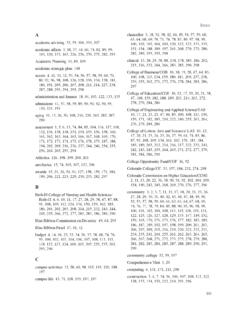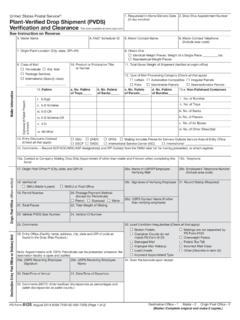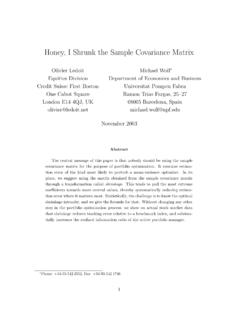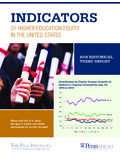Transcription of The Globalization of Trade in Retail Services - OECD
1 The Globalization of Trade in Retail Services Report commissioned by the OECD Trade Policy Linkages and Services Division for the OECD Experts Meeting on Distribution Services , Paris 17 November 2010 Neil Wrigley Professor of Economic Geography University of Southampton Southampton SO17 1BJ, UK Email: Michelle Lowe Professor of Retail Management University of Surrey Guildford, GU2 7XH, UK Email.
2 1 Aims and Background In this Retail sector study commissioned by OECD to inform the expert meeting on distribution Services to be held on November 17 2010, the aims are to: explain how and why the Retail sector has internationalised its operations over the past two decades and the characteristics of that process; highlight current and potential future trends in the internationalisation of the sector; consider how Trade , investment and regulatory policy have shaped and continue to shape the international activities of retailers; assess the importance of e-commerce in international retailing and any potential restrictions on its development; assess policy areas and measures which might be included in the Retail part of a Services Trade restrictiveness index (STRI).
3 The study is written from the perspective of academic social scientists who have contributed (Coe & Wrigley, 2009; Wrigley & Lowe, 2002, 2007) to research and scholarship on the Retail sector and multinational retailers in the global economy, but who are not Trade policy analysts. An important aim of the study is to add value to the OECD debates from that wider perspective. Sector background In all OECD economies, the distribution sector provides a crucial and dynamically evolving link between producers and consumers. At the simplest level the sector typically offers a substantial contribution to economy-wide employment frequently being the second largest sector in a national economy whilst simultaneously providing a significant contribution to both business activity and GDP.
4 Studies in the 1990s - Pilat (1997) for OECD placed its contribution to employment at typically around 13-17%, to business activity (defined in terms of the share of total enterprises in the economy which are in the distribution sector) at around 25-30%, and to GDP in 8-17% range. Within the distribution sector (which includes both Retail and wholesale Trade ) the large majority of these contributions to national economies are provided by retailing an industry which over the past three decades has increasingly been viewed as dynamic and innovative. During the 1980s and 1990s, it was an industry transformed by three interrelated forces.
5 First, by remorseless processes of concentration which moved it - albeit at markedly different rates across OECD member states - from an industry whose market structure had typically consisted of small enterprises to one which, in 2 many countries, now accounted for some of the largest firms in the national economy. In response, and for the reasons discussed by Wrigley and Lowe (2002, 52-4) - including the development and progressive expansion of retailer own-label products to challenge existing manufacturer brands, and retailers ability to induce competition between and counteract the market power of their manufacturing suppliers - the ever larger Retail chains created by that concentration began to exercise progressively increasing buying and bargaining power relative to those suppliers Indeed, as early as the mid 1980s in some OECD countries, Grant (1987)
6 Was able to describe a fundamental shift in the balance of power in consumer goods distribution .. [characterized by] the replacement of manufacturers dominance of distribution channels by that of the Retail chains Secondly, reflecting that shift in the balance of power in favour of the retailers and facilitated by an ICT-enabled revolution in distribution and systems, retailers emerged as the lead firms in buyer-driven supply chains. In other words retailers increasingly assumed the role of channel captains within supply chains which progressively shifted from supply push to demand pull in character (Wrigley, 1998, 116).
7 Thirdly, and intertwined with both of the previous developments, the industry was transformed by the adoption of processes of lean retailing (Abernathy et al, 2000). That is to say, by integrated logistics and supply chain management methods which underpinned just-in-time demand-pull supply systems systems which essentially linked reordering to real-time electronic point-of-sale (EPOS)-recorded consumer demand, allowed tracking of orders from manufacturer to retailer, and underpinned substantial reductions in both retailer inventory holdings and the amount of capital tied up in those holdings.
8 Figure 1 illustrates that reduction and shows that it largely occurred during the 1980s and early 1990s in the case of the major UK retailers Figure 1: The emergence of lean retailing - reductions in retailer inventory holdings in the 1980s/early 1990s by the UK s leading retailer (Tesco) Source: adapted from Burt et al (2010) 0102030405019611971198119912001 Stock Days 3 From the mid 1990s onwards, the transformed Retail industries of a small number of OECD countries which had been at the forefront of these three interrelated transformations began a period of sustained engagement with the global economy essentially as exporters of Retail capital and expertise.
9 Conversely, other OECD countries, whose Retail systems remained essentially traditional in the mid 1990s, experienced that engagement in an importer mode. The late 1990s saw a rapid acceleration of Retail FDI, largely by European and US retailers and primarily into the emerging markets of East Asia, Central/Eastern Europe and Latin America. It was accompanied by the emergence of an embryonic group of Retail transnational corporations (TNCs) firms which, simultaneously, rapidly expanded the scope and scale of their store networks in emerging markets whilst also putting into place extensive and closely managed regional and global sourcing networks.
10 Several factors facilitated these developments including: opportunities provided by the opening of emerging markets to Retail FDI via policies of full or partial market access liberalization; push factors relating to mature and increasingly tightly regulated home markets of the proto- Retail TNCs; the availability of free cash flow and debt finance for expansionary investment; and attempts to emulate the first mover benefits seen to have been enjoyed by some of the initial major retailers to internationalise their operations. Additionally, ICT technologies provided essential tools for effective management of large networked Retail firms (Dawson, 2007, 373).
















